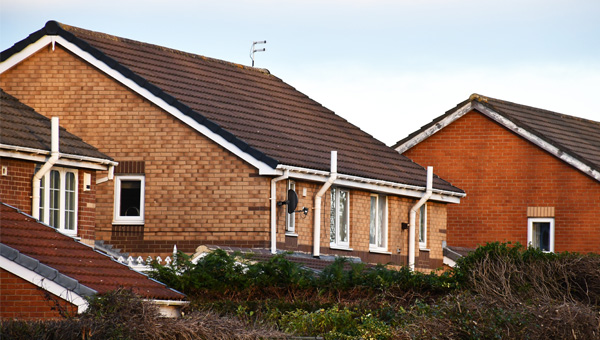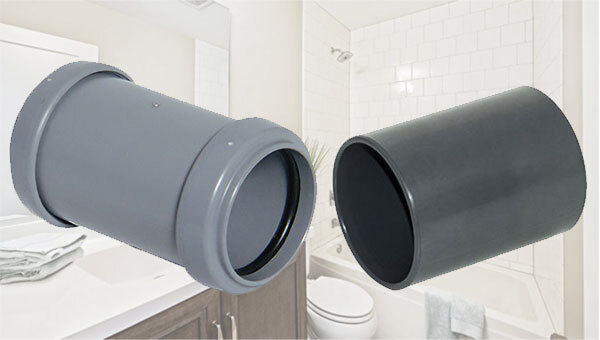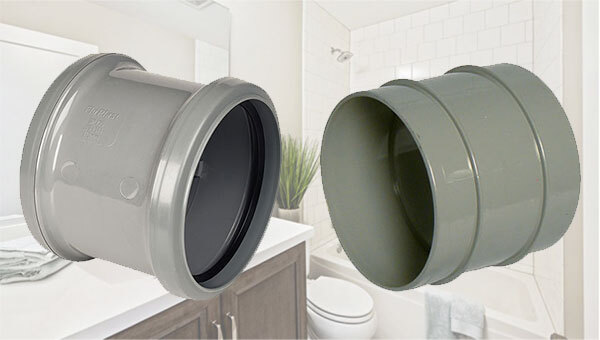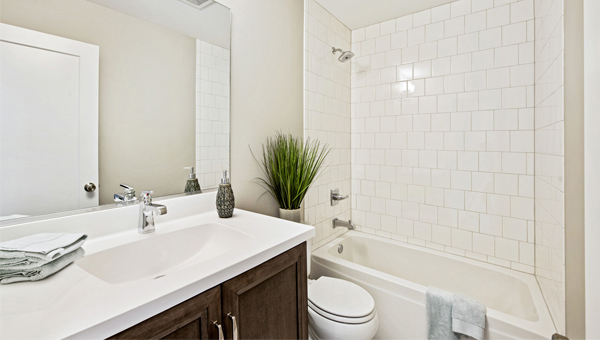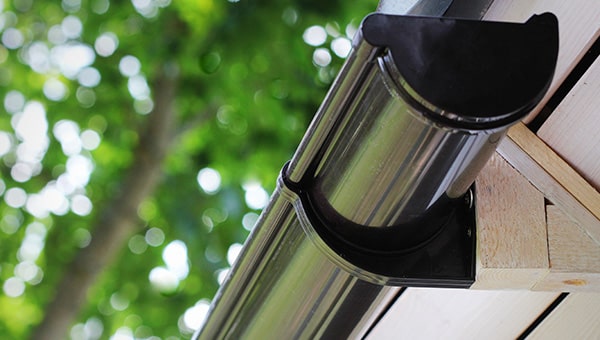Soil Pipe and Waste Pipe Systems: Frequently Asked Questions
What is the difference between a Soil pipe and a Waste pipe? Is Push-fit better than Solvent Weld? Can you connect Waste pipes to a Soil Stack? Find out the answers to these questions and many more right here.
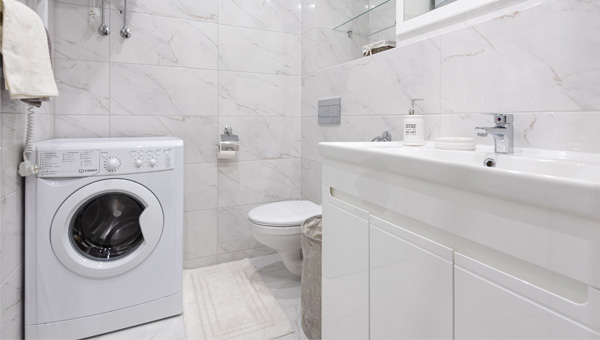
The topic of soil and waste systems can be a confusing one, despite the systems themselves being quite simple, and it can be difficult to find the answers you need all in one place. For that reason, we've put together this handy FAQ article to hopefully answer all your burning soil and waste related questions.
General Soil & Waste FAQs
Commonly asked questions about soil and waste systems.
What is the difference between a Soil Pipe & a Waste Pipe?
Put simply, soil pipes are designed to carry soiled water (blackwater) from toilets, urinals, or bidets, and waste pipes are designed to carry wastewater (greywater) from sinks, showers, baths and washing machines down into the mains sewer (or a storage/treatment plant if you have an off-mains system). Check out our Basic Guide to Soil & Waste Systems article for more information.
What size soil and waste pipes do I need?
The following sizes are the standard requirements for modern plastic soil and waste pipes. Older pipes and those made from other materials will differ slightly.
- Soil Pipes - 110mm for toilets, urinals, bidets, and soil stacks.
- Waste Pipes - 32mm for small hand basins, 40mm for sinks, showers, baths, washing machines and dishwashers, 50mm for commercial applications and connecting multiple waste pipes to a single flow.
Soil pipes need to be of a larger diameter than waste pipes because they have to carry solids as well as liquid waste. If your waste pipes connect to the soil stack, a 40mm discharge pipe should be sufficient to facilitate this for a maximum of two groups of appliances per floor. If you are connecting more appliances to the soil stack, have a separate waste system that doesn't connect to it, or are installing more commercial applications, a 50mm discharge pipe would be recommended.
What is a Soil Stack?
A soil stack is a vertical run of 110mm soil pipe that usually makes up the core of a building's plumbing system. It joins all interior soil and waste pipes together to form a single flow that discharges into the mains sewer or an off-mains sewage treatment/storage solution.
The soil stack will often be an internal installation in modern buildings, but it is quite common to still see them installed externally on older properties. As well as discharging into the main drains, the soil stack also typically provides a ventilation point at the top of the building to release harmful gasses into the atmosphere and an air intake point to maintain a balance of air pressure in the system.
What is the difference between a Soil Stack and a Waste Stack?
The term "waste stack" refers to the large diameter pipe that runs vertically through the property connecting all the waste pipes into a single flow. A soil stack does the same thing for the property's soil pipes.
In many properties, the soil and waste pipes will both connect to the same vertical pipe run, making the soil stack and waste stack one and the same. However, for properties with separate soil and waste systems, the waste stack will be a vertical run of 50mm waste pipe that collects the discharge from the property's sinks, showers, bathtubs, washing machines, and dishwashers into a single flow that drains into the mains sewer.
What is a Soil Vent Pipe?
The term Soil Vent Pipe (SVP) refers, specifically, to a length of 110mm soil pipe in a vertical soil stack that terminates above the roofline of a property. While often fitted with a perforated cover (to prevent unwanted access by birds or debris), the pipe itself is left open to the atmosphere for the safe venting of harmful sewer gasses. It also allows air to be drawn into the system to re-balance any pressure build-ups.
What is an Air Admittance Valve?
An Air Admittance Valve (AAV) is a one-way mechanical valve that is designed to allow the free entry of air into a soil and/or waste system to help maintain atmospheric pressure whilst preventing the escape of foul gasses.
Soil Pipe Air Admittance Valves can be installed in some combined soil and waste systems in place of a soil vent pipe, allowing the soil stack to terminate inside the property instead of out through the roof. Often Waste Pipe Air Admittance Valves can also be installed locally at the site of a plumbing fixture to help balance the pressure in larger systems. This is especially important for separate waste systems that aren't connected to the soil stack to help combat problems associated with negative pressure build-ups.
What is the difference between a Soil Vent Pipe and an Air Admittance Valve?
The primary difference between Soil Vent Pipes and Air Admittance Valves is that, while they both work to keep the pressure balanced in soil and waste systems, only the Soil Vent Pipe can release sewer gasses into the atmosphere.
Because of this, Soil Vent Pipes must be open to the outside air and terminate at least 900mm above any window or opening to the building within 3 metres of it. Air Admittance Valves, on the other hand, need only terminate 200mm above the highest wet entry point. For a more in-depth comparison, check out our Soil Vent Pipes vs Air Admittance Valves article.
Do soil pipes need vents?
Every soil system needs to be vented to safely release harmful gasses, but not every property needs to have a vent. Typically, unless you have an off-mains drainage solution (in which case your soil system absolutely MUST be vented), only one in every five standard residential buildings on the same run needs to be vented.
Always check with building regulations and consult a professional before making changes to the way your soil system is vented if you are in any way unsure.
Do waste pipes need vents?
Waste pipes on their own do not technically need to be vented in the same way as soil pipes. Since the gasses produced by human waste should not be present in the water from your sinks and bathtubs, waste pipes do not need an open-air vent pipe to release them.
However, they still need to be able to draw air in to address any pressure imbalances and, therefore (if not connected to a vented soil stack), should always at least be fitted with an Air Admittance Valve.
Do I need a waste trap?
Yes! A waste water trap is a vital component of any system that connects to a water-using appliance or fixture. These traps, installed at the point of connection to toilets, sinks, bathtubs etc., create a water seal between the drains and the appliance to prevent bad smells, bacteria and insects from entering your property.
They are designed to be easily taken apart, without disturbing the rest of the pipe system, to facilitate the removal of blockages.
Do I need Solvent Weld or Push-Fit connections?
Push-Fit soil and waste pipes are easier to work with, quicker to install, and usually cheaper, which makes them ideal for DIY projects. Solvent Weld soil and waste pipes require permanent jointing and take longer to install, but they are more impact resistant and less likely to leak.
Deciding on which is best for you will depend on the pipes you are connecting to, your level of plumbing experience, and your budget. A general rule of thumb is to keep your connections consistent throughout your system (i.e. connect push-fit to push-fit and solvent to solvent).
Does the pipe colour matter in soil & waste systems?
Drainage pipes installed underground are usually always a terracotta orange colour, as this makes them easy to identify. Pipes installed above ground are usually black, grey, or white based on personal choice. Just be aware that, if installed externally, certain properties, such as listed buildings, may have restrictions around the pipework's colour and material.
What type of soil and waste system does my property have?
This will largely depend on the age of your property. Older buildings will often have separate soil and waste pipe systems, whereas newer properties will most likely have a combined system with all pipes running into a soil stack.
If you have a soil stack that runs up an external wall, check to see what other pipes connect to it. Any pipes smaller in diameter than the stack are likely to be waste pipes, meaning you have a combined system. However, if in any doubt, always contact a professional plumber for assistance.
What are the working temperatures of soil and waste pipes?
According to the manufacturer of our Floplast range of above ground pipes, "soil and waste systems may be used to carry liquids when subjected to a continuous flow, with a maximum temperature of 76°C. Intermittent discharges of up to 100°C may occur, provided that a duration of less than two minutes is observed."
Soil and Waste Installation FAQs
Commonly asked questions about installing soil and waste systems.
How do you install a soil and waste system?
By calling in a professional plumber! Soil and waste pipe installations are not something you want to risk getting wrong, as the results can be...unpleasant. If you do want to DIY the job, we would recommend using the FloPlast Ring Seal and Push-fit ranges of soil and waste pipes, as they are much easier to work with than solvent weld. A range of informative and helpful installation guides are available for download on FloPlast's own website if you do wish to go down that route.
Hiring a professional is always the safer option, however, and (if you use a site like Checkatrade.com to find a reliable, trustworthy tradesperson) it can give you the peace of mind in knowing that the job will be done right. Professional quotes will also usually factor in the removal and disposal of any old pipework being replaced for you - something you’ll have to sort out yourself if you go down the DIY route.
Are soil and waste pipes affected by building regulations?
Yes — building regulations in England, Wales & Scotland require that any installed soil and waste systems are fit for the purpose of removing soiled and waste water from your property. However, as long as you buy quality brands from trusted suppliers, and ensure your installation is done correctly, this shouldn’t be anything you need to worry about.
If you have an external soil stack, just be aware that Building Regulations can also stipulate what types of pipe can and can’t be used on listed and heritage buildings, which usually require a like-for-like match to the existing material and appearance.
Soil and waste pipe maintenance and repair work doesn’t normally, for most properties, require any planning permission, but it’s always worth double checking with your local authority just to be sure.
Do soil and waste pipes need to be installed with a fall?
Yes! To aid their drainage efficiency, both soil and waste pipes, when installed horizontally, should slope down gently from the appliance to the vertical discharge pipe/soil stack.
Building Regulations advice (for England & Wales) varies between applications, but a minimum of 18mm per meter is recommended for all (i.e. the height of the pipeline should drop 18mm for every 1 meter along its run towards the discharge point). Any shallower than this, and the water will not flow away properly. For soil pipes, the maximum fall should be no greater than 90mm per meter, otherwise the water will flow too fast to carry solids along with it. Always check with the current building regulations for your region before beginning your installation.
At what distance should support brackets be installed along soil and waste pipelines?
See the table below for BS EN 12056:2000 maximum distances for support guidance:
| Soil and Waste Maximum Support Bracket Distances |
| Size |
Vertical |
Horizontal |
| 32mm |
1.2m |
0.5m |
| 40mm |
1.2m |
0.5m |
| 50mm |
1.2m |
0.6m |
| 110mm |
2m |
1m |
| Soil and Waste Maximum Support Bracket Distances |
| Size |
Vertical |
Horizontal |
| 32mm |
1.2m |
0.5m |
| 40mm |
1.2m |
0.5m |
| 50mm |
1.2m |
0.6m |
| 110mm |
2m |
1m |
Can you connect a waste pipe to a soil stack?
Yes! Waste pipes can be connected to a soil stack with the use of an appropriate boss fitting. From Strap Bosses and Boss adaptors, which simply require a hole to be cut into the soil stack, to Boss Pipes that can be installed as a junction with multiple waste pipe connection points, there are a variety of options available.
Can toilet and sink waste join together?
Technically, yes. In a combined soil and waste system, the waste from your toilets and sinks will join together when they run into the soil stack. However, if you want to connect the waste pipe from your sink to the soil pipe from your toilet before they reach the soil stack, that is a bit more complicated.
If, for example, you have a 32mm waste pipe draining from a small hand basin into a 110mm soil pipe from your toilet, the change in pressure caused by air being forced down the soil pipe during a flush could potentially cause the water in the handbasin waste trap to be sucked out. For this reason, we would recommend keeping the pipework separate until it reaches the soil stack, or strongly advise seeking the advice of a professional plumber if not.
Can bath and shower waste join together?
Yes, but care should be taken during installation. Since both appliances use the same size pipework (40mm waste pipe), having them connect to the same discharge pipe shouldn't be a problem. However, the connection to that discharge pipe must be well below the level of both appliances, or the discharge pipe must be increased from a 40mm to a 50mm diameter. If not, there is a good chance that the water flowing out of one appliance could back up into the other.
What size waste trap do I need?
See the table below taken from Building Regulations Part H for minimum waste trap sizes and seal depths:
| Minimum Waste Trap Sizes and Seal Depths |
| Application |
Diameter of trap (mm) |
Depth of seal (mm of water or equivalent) |
Washbasin¹
Bidet |
32 |
75 |
Bath²
Shower² |
40 |
50 |
Food waste disposal unit
Urinal bowl
Sink
Washing machine²
Dishwashing machine² |
40 |
75 |
WC pan - outlet <80mm
WC pan - outlet >80mm |
75
100 |
50
50 |
¹ The depth of seal may be reduced to 50mm only with flush grated wastes without plugs on spray tap basins.
² Where these applications discharge directly to a gully the depth of seal may be reduced to not less than 38mm.
³ Traps used on appliances with flat bottom (trailing waste discharge) and discharging to a gully with a grating may have a reduced water seal of not less than 38mm. |
| Minimum Waste Trap Sizes and Seal Depths |
| Application |
Diameter of trap (mm) |
Depth of seal (mm of water or equivalent) |
Washbasin¹
Bidet |
32 |
75 |
Bath²
Shower² |
40 |
50 |
Food waste disposal unit
Urinal bowl
Sink
Washing machine²
Dishwashing machine² |
40 |
75 |
WC pan - outlet <80mm
WC pan - outlet >80mm |
75
100 |
50
50 |
¹ The depth of seal may be reduced to 50mm only with flush grated wastes without plugs on spray tap basins.
² Where these applications discharge directly to a gully the depth of seal may be reduced to not less than 38mm.
³ Traps used on appliances with flat bottom (trailing waste discharge) and discharging to a gully with a grating may have a reduced water seal of not less than 38mm. |
Can you join plastic soil and waste pipes to other materials?
Yes! This can be achieved through the use of universal adaptors, such as Floplast's range of UNICOM waste pipe compression fittings, which are designed to compensate for any discrepancies in the size difference of the pipes (within certain tolerances) in order to ensure a watertight seal.
Flexible rubber plumbing adaptors can also be used for both waste pipe and soil pipe sizes. Whilst a more expensive solution, they do allow for greater flexibility and tolerances between materials. This is especially useful if you are unsure of the exact size of the pipe you need to connect to, or if it has a rough/pitted surface that would otherwise make it difficult to achieve a good seal.
Can Air Admittance Valves be installed outside?
Yes and no. Documentation for Floplast's AX110 External Air Admittance Valve states that "Document H of the Building Regulations Clause 1.33 states that AAV's should not be used externally or in dust laden atmospheres." However, due to the termination restrictions of soil vent pipes, and the increasingly common conversions of lofts/roof areas into habitable spaces, they also advise that "Building Control Officers are accepting their use," but strongly advise that "confirmation of acceptance of the use of the AX110 is gained from Building Control prior to installation."
How deep should soil pipes be buried outside?
Technically, a soil pipe (i.e. a black, white, or grey 110mm pipe) should only be installed above ground. Once the soil pipework goes below ground, it should be connected to a terracotta foul water drainage pipe. Check out our Underground Drainage: Installation and Principles article for guidance on this.
Soil and Waste Maintenance FAQs
Commonly asked questions about maintaining soil and waste systems.
How do you fix a leaking soil pipe?
Long term, you will want to replace the leaking section for peace of mind. For a quick fix until that can be done, however, use a plastic repair epoxy putty or a self-fusing silicone waterproof repair tape around the leaking area. Just remember that these are temporary solutions and should not be relied upon to fix the leak permanently.
How can you tell if your soil pipe is blocked?
Aside from the obvious blocked toilet, other indications of a blocked soil and waste system can be:
- Plugholes making a gurgling sound.
- Slow drainage of water from toilets, sinks, bathtubs etc.
- Unpleasant odours coming out of the drains.
How do you clear a blocked soil pipe?
If the blockage is before entrance into the soil stack, using a toilet plunger should free up most obstructions. This will be indicated by a sudden drop in the water level within the toilet bowl. However, if plunging doesn't work, it could be a sign that the blockage has reached the soil stack or the underground drainage pipe that connects your property to the mains sewer. If that is the case, it's time to call in a professional.
And that's it for this soil and waste FAQ. Hopefully, we have been able to answer all the questions you had. Should you have any further ones or need advice on how to install, operate, or maintain your soil and waste systems, contact us today — our team of experts is always on hand to help with all of your drainage needs.



